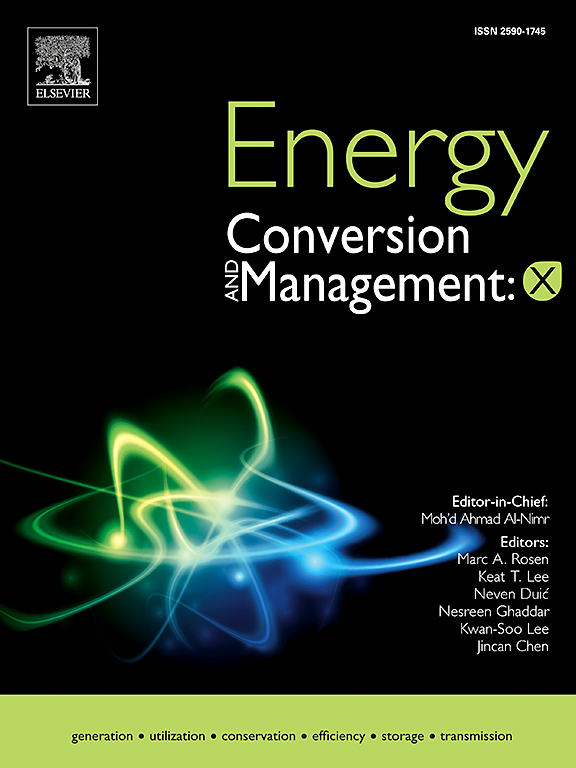Experimental investigation of the ignition dynamics in a premixed annular combustor using a pre-chamber ignition system
IF 7.1
Q1 ENERGY & FUELS
引用次数: 0
Abstract
In this paper, the ignition characteristics in a MICCA-type annular combustor are studied for the first time using a pre-chamber combustion (PCC) system. The PCC is proposed to replace the traditional spark electrode ignitor in the annular combustor, aiming to shorten ignition time and prevent misfiring. The PCC system is commonly utilized to initiate the ignition process in internal combustion (IC) engines by generating high-temperature turbulent jets that ignite the fuel/air mixture in the main combustion chamber (MCC). The PCC is integrated into a premixed annular combustor consists of sixteen swirling burners. The ignition characteristics and flame propagation patterns are investigated using a high-speed camera under varying conditions of equivalence ratios, bulk velocities, and thermal power levels. Experimental results demonstrate that the PCC exhibits a high ignition response without misfire. The induced turbulent jet from the PCC is observed to propagate into both sides of the annular combustor with high energy, creating a significant initial flame area along the jet trajectory. This enhances the ignition probability compared to traditional spark electrode ignition systems. Due to the higher burning rate resulting from the jet ignition, the light-round time is reduced by 41 % compared to traditional spark electrode ignition systems operating at the same equivalence ratio of 0.81 and the same bulk velocity of 3.22 m/s. This improvement is particularly advantageous for high-altitude re-ignition scenarios.
使用前室点火系统的预混合环形燃烧器点火动力学实验研究
本文首次使用预室燃烧(PCC)系统研究了 MICCA 型环形燃烧器的点火特性。PCC 被提出来取代环形燃烧器中的传统火花电极点火器,旨在缩短点火时间并防止误点火。PCC 系统通常用于启动内燃 (IC) 发动机的点火过程,通过产生高温湍流射流来点燃主燃烧室 (MCC) 中的燃料/空气混合物。PCC 集成在一个由十六个漩涡燃烧器组成的预混环形燃烧器中。在不同的等效比、体积速度和热功率水平条件下,使用高速摄像机对点火特性和火焰传播模式进行了研究。实验结果表明,PCC 具有很高的点火响应速度,不会出现失火现象。据观察,来自 PCC 的诱导湍流射流以高能量传播到环形燃烧器的两侧,沿射流轨迹形成了很大的初始火焰面积。与传统的火花电极点火系统相比,这提高了点火概率。由于喷射点火产生了更高的燃烧率,与传统的火花电极点火系统相比,在相同的当量比(0.81)和相同的体积速度(3.22 米/秒)下,光轮时间缩短了 41%。这一改进对于高空再点火情况尤为有利。
本文章由计算机程序翻译,如有差异,请以英文原文为准。
求助全文
约1分钟内获得全文
求助全文
来源期刊

Energy Conversion and Management-X
Multiple-
CiteScore
8.80
自引率
3.20%
发文量
180
审稿时长
58 days
期刊介绍:
Energy Conversion and Management: X is the open access extension of the reputable journal Energy Conversion and Management, serving as a platform for interdisciplinary research on a wide array of critical energy subjects. The journal is dedicated to publishing original contributions and in-depth technical review articles that present groundbreaking research on topics spanning energy generation, utilization, conversion, storage, transmission, conservation, management, and sustainability.
The scope of Energy Conversion and Management: X encompasses various forms of energy, including mechanical, thermal, nuclear, chemical, electromagnetic, magnetic, and electric energy. It addresses all known energy resources, highlighting both conventional sources like fossil fuels and nuclear power, as well as renewable resources such as solar, biomass, hydro, wind, geothermal, and ocean energy.
 求助内容:
求助内容: 应助结果提醒方式:
应助结果提醒方式:


